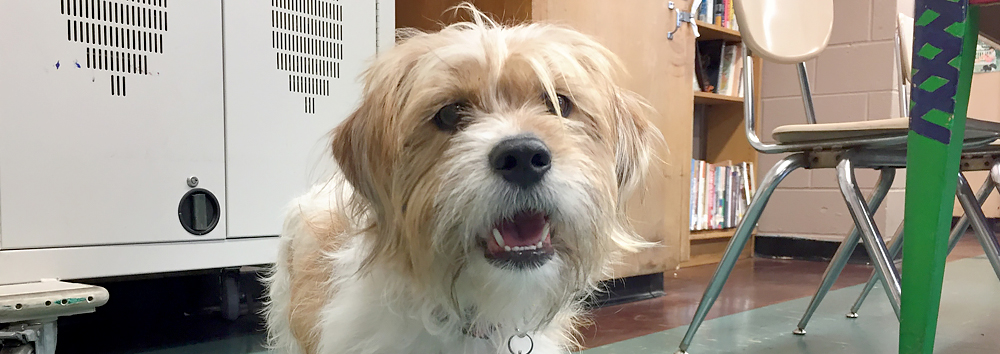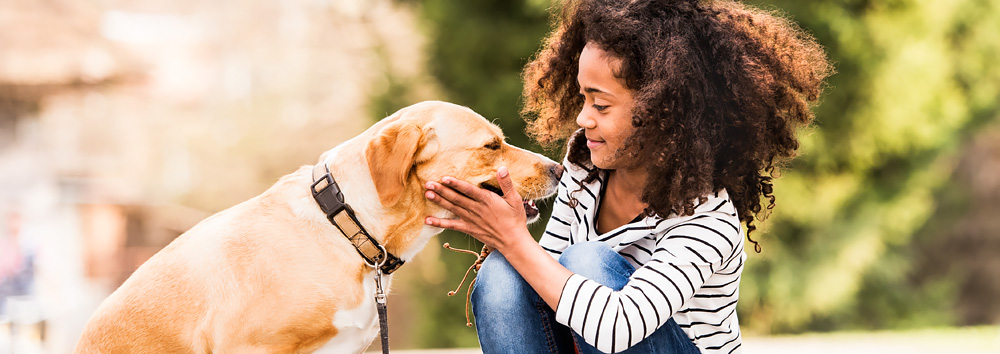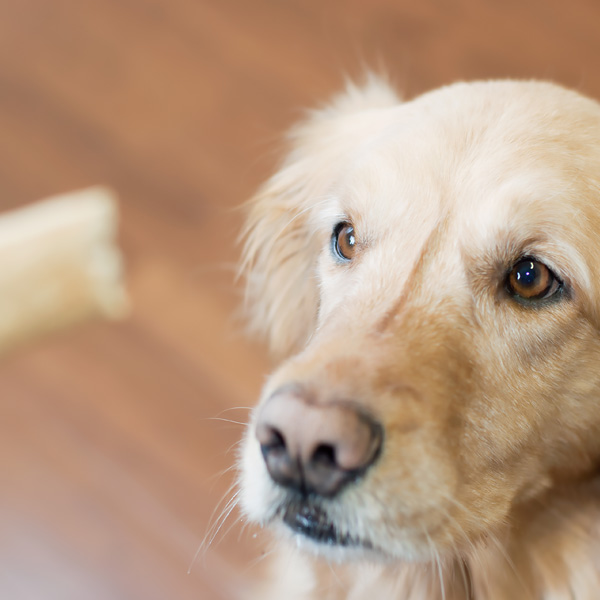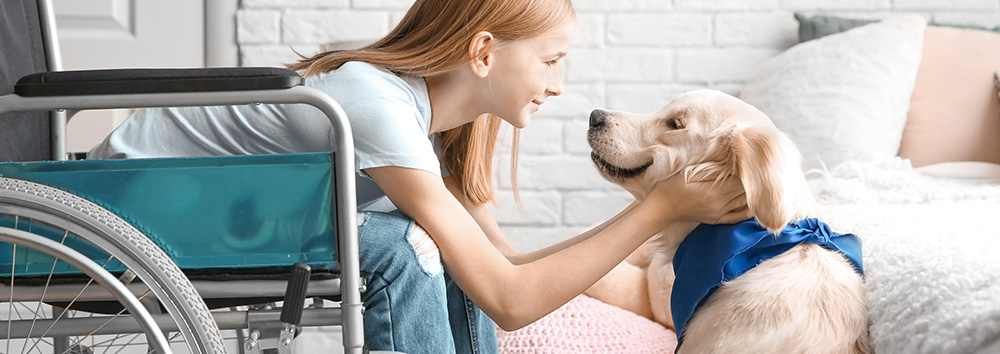Mutt-i-grees School Dog Lessons

Curriculum Target: Achieving Awareness
Understanding and Helping Ourselves and Others: Working together to take positive action and create win-wins for everyone!
Students will learn about the plight of shelter dogs and understand how they can help homeless animals and themselves by working with their Mutt-i-grees School Dog as a therapy partner.
Discussion Points
- The importance of language and the power of our words: What we say and how we say it.
- The dog is our “companion” and we are the dog’s “guardian.” The person who adopts the dog will be the dog’s “primary caregiver” and “primary guardian” not “owner” as dogs (and all animals) are sentient beings and not “things to own.” Dogs are the students’ therapy partners versus “tools” or “comfort” for “use”. It is a reciprocal relationship.
- How else do the students use their words? Do their words hurt or heal others?
- What about tone of voice? Did you ever notice when you use a friendly, soothing tone toward others, including animals, that it relaxes them and makes you more approachable? How do you feel when people say kind words to you in a friendly voice? What impact do we have on others through our language and tone? These same questions all relate back to how we treat our four-legged companions.
The importance of non-verbal communication
All animals, including humans, communicate non-verbally with their body language and facial expressions. Dogs do as well!
Grades 4-6
Lesson 3.3: How Might a Mutt-i-gree Feel?
Lesson 4.2: Listen to the Dog! (see also Dog Dialog Feature “What is the Dog Trying to Tell Us?” (Body Language) which appears right before Lesson 4.2)
- How do you use and understand non-verbal communication effectively? How will you use your observation skills to understand what others need, including your companion dog?
- The importance and power of our actions: What we do and how we do it.
The Five Freedoms
All animals, humans and others, have needs that are crucial to their survival and well-being.
The Five Freedoms outline five aspects of animal welfare under human control. They were developed in response to a 1965 United Kingdom (UK) Government report on livestock husbandry, and were formalized in a 1979 press statement by the UK Farm Animal Welfare Council. The Five Freedoms have been adopted by professional groups, including veterinarians, and organizations such as the World Organization for Animal Health, the Royal Society for the Prevention of Cruelty to Animals, and the American Society for the Prevention of Cruelty to Animals.
The five freedoms are:
- Freedom from hunger or thirst by ready access to fresh water and a diet to maintain full health and vigor.
- Freedom from discomfort by providing an appropriate environment including shelter and a comfortable resting area.
- Freedom from pain, injury, or disease by prevention or rapid diagnosis and treatment.
- Freedom to express (most) normal behavior by providing sufficient space, proper facilities, and company of the animal’s own kind.
- Freedom from fear and distress by ensuring conditions and treatment which avoid mental suffering.
When you adopt your Mutt-i-grees School dog, everyone will be responsible for making sure your dog therapy partner has what she/he needs to thrive. You will ensure her/his Five Freedoms.

Curriculum Target: Finding Feelings
Effectively using verbal and non-verbal communication.
Activity: Dog Mind vs. Lion Mind
Digging Deeper – Telling Our Stories: The Human brain responds to stories. They help us organize information and access emotions. Photos, videos, and books that tell a story and elicit empathy and compassion have the same impact on our brain. From research on mirror neurons, we now know that we don’t need to experience something to feel and elicit empathy, but can observe others being compassionate and the same neurons fire in the brain.
Topics to Cover
- Explain the long history of the dog-human bond and why human relationships with dogs are so special
- Cover hormone releasers and stress reducers (eg. oxytocin) that occurs in humans and their canine companions when they are with each other
- Explain the “Hand Model” of the brain and how to learn what happens in our brains when we are triggered and we “Flip Our Lids” (Dan Siegal) – the fight-flight-freeze response and how to stay calm by learning to RESPOND not REACT (remember Dog Mind versus Lion Mind). Also view the Youtube version.
- It is important that we learn to stay calm, even when we are feeling big emotions, especially around our Mutt-i-grees School Dog. You are learning about your canine companion and your Mutt-i-gree is also learning about you.
- What traits, qualities, and characteristics have you learned about your Mutt-i-gree dog? What traits, qualities, and characteristics has your school dog learned about you? Are these the traits you want others to learn about you? How did you come to your conclusions?
- What are your values? Does your behavior match your values?
Telling Our Stories – How We Tell Them Impacts 0ur Emotions and How We Relate to the World
We are all shaped by our life experiences. Essentially, we are all the stars of our own life movies and we all have a story to tell. The way we remember our stories and experiences and think about them, will impact how we feel about our lives, ourselves, and others. Sometimes the versions of our stories—our memories—help us feel peaceful and powerful or a range of other supportive emotions. Sometimes they do the opposite, leaving us feeling angry, sad, jealous, or resentful.
- Animals have their stories too. What is your therapy dog partner’s story? They may not have it so easy, but dogs are usually very resilient and able to “bounce back,” even from the most horrible experiences at times.
- You may have noticed by being around your Canine Companion that animals usually know how to just “be.” They don’t regret the past or worry about the future. When they have all they need to survive and thrive, they are usually very good at being calm and in the present moment. How can observing them “just being” help us observe and notice our own feelings and emotions? Feelings and emotions come and go. The only thing we can guarantee is that they will change. If you feel sad, you can remind yourself that you will feel happy again. Of course, the reverse is also true. What matters is that you remember that even feelings that are very “big” pass, like the ocean tide coming in and going out or clouds passing by in the sky. It is important to remember to use strategies to stay calm. Strategies that help: slow and deep breathing, physical activity, focusing your thoughts on positive images and words, and of course observing your canine companion. Think about how your past stories impact the way you feel about your life in the present moment. Is your life story empowering? Will it enable you to create the best life you can for yourself and others in the future? Or, is your story holding you back, and you are letting difficult past experiences affect the present, and ultimately, your future?
Discussion Questions
- What is your dog’s story? How does her/his story impact them?
- What is your story? Is your story about yourself supportive? Does your story move you powerfully forward or hold you back?
- Have you learned anything from your therapy dog partner to help you stay strong, powerful and resilient, no matter how many difficulties you have experienced before, or when life’s inevitable challenges arise?
Activity: Dog Mind vs. Lion Mind
Have you ever seen your therapy dog (or any dog!) become fixated by a treat and follow the treat with their eyes? Have you seen them run wherever you throw the treat? While we humans tend to love and relate to dogs, sometimes having this kind of reactive “dog mind” that gets distracted and fixated on things like treats doesn’t serve us well. Now think of a lion. Lions usually look very calm, observing everything around them slowly and carefully so they can respond thoughtfully and not react.


Discussion questions
- Do you notice when you have “dog mind” or “lion mind” that sometimes the “dog mind” can be fun and exciting, but we want to make sure we have our lion mind too. What are the benefits of dog mind versus lion mind?
- Can you blend them sometimes to have a more balanced response to things that happen around you? How?

Curriculum Target: Encouraging Empathy
We Are All Connected: Gratitude for Our Mutt-i-gree Dog
Activity: Three Kind Things
Service Learning Project: Empowering Youth Through Helping Animals
After spending time with your canine companion, you are probably noticing that humans and dogs share a special bond. You can speak here about the relationship that goes back 30,000 years. This human-animal bond exists between humans and all other animals. Our global life form depends on this connection. All animals (companion animals, wildlife, and farm animals) are individuals with hearts and minds and lives that matter to them. Non-human animals need our help in many ways. What ways has your therapy partner encouraged you to have empathy for animals? What projects can you think of that will allow you to be a superhero for animals? While there are many problems to solve, you may all want to choose one as a group to focus on. You can make a difference. When things get difficult along the way, you can remind yourself of the quote below from famous anthropologist Margaret Meade:
“Never doubt that a small group of thoughtful, committed citizens can change the world; indeed, it’s the only thing that ever has.”
How will you change the world for animals, and, in turn, for people?
Gratitude
After learning all the ways that non-human animals need our help, you might feel some sadness and despair. Remember, YOU have the power to make a difference. The world will change when we do. Remember to stay grateful. Gratitude is one of the best ways to keep yourself balanced and feeling good, even when faced with solving big problems — either your own problems or problems in the world. What do you have to feel grateful for? Are you grateful for your rescue dog? In what ways? Feel the joy and gratitude that this relationship brings you. What else brings you these feelings of joy and gratitude?
When you wake up in the morning, think of three things that you are truly grateful for to start the day with an open heart and positive mindset.
Three Kind Things
Being kind to others can lift our spirits and bring us back into our power to stay positive. An activity called “Three Kind Things” is a great way to keep our emotions balanced and our spirits high as we do the work that needs to be done in the world to make it a more just and equitable place for all animals.
- Do one kind thing for someone else every day. Take the time to notice one kind thing someone did for you. Do one kind thing for yourself. Doing kind things for ourselves, and having compassion for ourselves when we make mistakes, can usually be very difficult. It is very important to have compassion for ourselves. It will help us bounce back when we feel like we have made a “mistake”, and allow us to spread kindness and compassion to others around us.
- How can you show compassion to yourself? How can you show compassion to others?
Note: Students research issues for a service learning project that helps raise awareness for homeless animals and carry this out as a team to fruition. They can share the results inspired by their Mutt-i-grees School Dog with their family, friends, and community. This would be a great filming opportunity and a great way to bring the students’ families and your community into the spotlight attracting media and also demonstrating the positive impact of social media.

Curriculum Target: Cultivating Cooperation & Dealing with Decisions
Adopting A Shelter Dog
Unfortunately, you will see that not all animals living in shelters have had all they needed to survive and flourish in their past environments. Some animals have been abused, neglected, or left at a shelter due to no fault of their own. This could because of changes in their household, such as a new baby being born, or because their guardians moved to a home that didn’t allow companion animals. Sometimes their human guardians do not want to give them up, but can no longer afford their care, or otherwise care for them, or they may be protecting them from violence in their household. Sometimes their guardians pass away unexpectedly and haven’t made arrangements for their care.
Sometimes dogs and cats scratch floors and furniture or go to the bathroom in the house. These animals can typically respond to training, but some owners cannot afford training or do not want to take the time to provide it. Sometimes animals may be aggressive towards human or other animals when at home. Once labeled a “behavior problem,” these animals have a very hard time getting adopted and need to be placed in an experienced home where they can be taught new skills with patience and care. Dogs who are aggressive or bite have typically been exposed to aggressive or intimidating humans or have not been socialized. When they are around kind humans who know how to work with them through providing praise and other kinds of positive reinforcement they can feel safe and trust humans again. Isn’t this much the same for humans?
Pit Bull-type dog breeds, usually any dog with big, block-shaped heads, are labelled as “Pit Bulls,” are often the victims of cruelty and abuse by the hands of humans. They are often used for dog fighting, either as a fighting dog or as a bait dog who is used to train fighting dogs. While many pit bulls are loving, loyal dogs, they are often in shelters because they are the victims of breed discrimination. Some cities and countries around the world have implemented laws that do not even allow pit bulls to live in some places. This decision is not based on anything an individual dog has done or not done, but just because of the way they look. Like all homeless animals, many of these types of dogs end up in animal shelters and are euthanized when they cannot find homes.
Discussion Points
- Have you ever experienced difficult times in your home or with your families as some of the dogs in the shelter have?
- Has your behavior ever been misunderstood? Have you ever been labelled and misunderstood like some dogs have? Has it ever been said that your behavior is a problem?
- Have you ever felt unwanted? Had nowhere to go or no one to care for you?
- Have you ever been discriminated against because of the way you look? Or have you discriminated against others because of the way they look?
- Is this what we want to see more of or less of in the world? How can we create a more just and humane world for all humans and non-human animals?
- Has anyone witnessed animal abuse? If you did: How did you handle it? Have you ever talked to anyone about it? Usually when an animal is abused in a household other vulnerable members of the household are suffering, too. This is called LINK violence because crimes like animal abuse, domestic violence, elder abuse and child abuse are linked to each other. (Understanding this LINK can help professionals working with different vulnerable populations understand signs of cruelty and neglect and intervene to help more effectively.) Has anyone had any experiences with this type of violence in their own lives? How do you think your Companion Dog may help you if you have?
- Why do you think society accepts that euthanizing an animal (“putting them to sleep”) is an acceptable solution to the shelter animal overpopulation problem? What other solutions exist that would be better for everyone? How can you get your community involved in working together and implementing these solutions?
Preparing to Adopt a Shelter Pet
When deciding to adopt a shelter dog, especially a working school dog, sometimes what you want or think you want is not necessarily the best fit for your home, the school, or the dog. You will have to practice compromising, problem solving, and coming to an agreement that can make everyone happy. Most importantly, you will have to think about the dog and what is best for her/him. Their personality, their ability to tolerate loud noises, and be around many young people will be some factors used to determine which dog is the right fit. You must put others first, and think about what will be best for your canine companion in his forever home and at your school. Of course, the primary guardian will have to be considered as they will be spending the most time with their new adopted dog and providing their overall care.
A Shelter Behavior Evaluation form will be used to help determine who will be the lucky dog to find their forever home and become your Mutt-i-gree therapy partner. Ask students to create a shelter Behavior Evaluation form. What should a form include?
Be Mindful
Dogs do not use words, but they do communicate non-verbally with their bodies and with sounds.
- When you meet the dogs, how will you use your observation skills to carefully interpret what they are telling you about who they are and what makes them comfortable?
You will likely feel sad for the animals you have to leave behind. Although many people who love animals want to take them all home, the reality is that one family cannot adopt all the animals in the shelter to solve the animal overpopulation problem. What can you do to help the animals who still need homes?
Some students start campaigns to educate people about the importance of spaying and neutering animals, so they do not continue to have babies that will add to the number of homeless animals. Some students look for organizations to work with who can provide free and low-cost spay and neuter in their communities. Others create social media campaigns, flyers, and “cage cards” to bring awareness to hard- to-adopt animals at the shelter and to spread the word to the community about all of the animals who need homes. Others focus on educating people to “adopt not shop” when they want to open their home to a companion animal. Still others focus on teaching people about the plight of Pit Bull-type dogs and the discrimination they face that leads them to be overrepresented in shelters and as abuse victims.
Activity
- What can you do to help? Create an action plan to help the animals you will have to leave behind at the shelter.
Use skills learned in preparation lessons to choose the dog that’s the right fit for your family. Show what the students have selected to do for the dogs they must leave behind. Have them make cage cards and social media posts to highlight the dogs they saw. Ask the students why they think someone should adopt these animals and who would be a good fit for them. Have students speak or write in the dog’s voice (from his/her point of view).
Training your Mutt-i-grees School Dog: How Animals Learn (Human and Non-Human!)
You will learn how dogs respond to positive reinforcement and clear, consistent, and kind interactions with humans. Humans optimally learn the same way! How have you learned things best? Do you get positive reinforcement for a job well done? Do you give positive reinforcement for a job well done?
Teach about how dog trainers shape behaviors and use positive reinforcement to teach dogs important skills for living with people.
Activity
- Write about how you learn best. What do you need to understand what others are expecting of you. Do you teach others about your learning styles and needs? How do you communicate this? What needs does your Mutt-i-gree dog have? How will you teach them with kindness and patience? What will you do or say to yourself if you get frustrated with your dog or your classmates/teachers/parents?
We hope this gives you a start and perks your creativity to create your own Social Emotional/Humane Education lessons.
Please don’t forget to contact us at: [email protected] if you should have any questions and better yet – to share your ideas!
Now, let’s get going on your Mission Mutt-i-grees! Saving Pets, Changing Lives!

